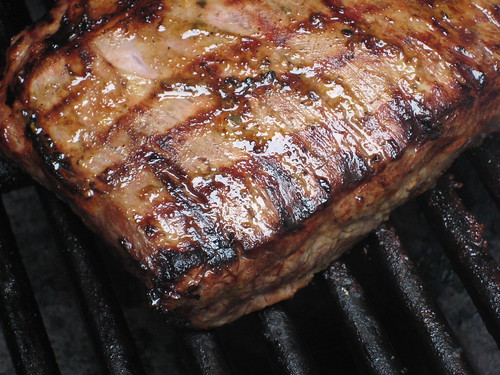 Grassfed beef is going mainstream!
Grassfed beef is going mainstream!
Emeril Lagasse, best known for his wildly popular TV cooking show, is now promoting well-marbled grassfed ribeye steaks. The steaks are delivered to your door air-sealed from Red Marble Steaks, Emeril’s personal grassfed beef brand. No msg flavor enhancing spread needed on these steaks like what is typically required at steak restaurants that rely on cheaper, tasteless, feedlot sourced cuts.
Emeril promotes these grassfed yummies as only needing a dash of salt and pepper and a few minutes on the grill to bring out the very full flavor and natural juices. The catch?
Two bone-in steaks weighing 20 oz each cost $74.95! That’s a wallet biting $30/lb!
Even the healthfood store carries grassfed steaks for much much less. A tender, tasty grassfed ribeye from Grateful Harvest, for example, typically costs around $11/lb. Find a local co-op in your area that buys grassfed steaks in bulk and you can sometimes get them for nearly half the store price at $6/lb! That is a full 80% less than Emeril’s brand!
A local, grassbased farmer can supply grassfed steaks at much lower cost as well.
Why Grassfed Beef?
Why even bother to source grassfed beef? Omega 3 fats, CLA, and Vitamin E, that’s why! Beef from cows finished on CAFO (Concentrated Animal Feeding Operation) feedlots have little to no omega 3 fats in their tissues. Omega 3 fats are those heart healthy fats that Westerners are so deficient in. Grassfed cows, on the other hand, have high levels of omega 3 fats in their tissues – around 3% of total fat content!
CLA is conjugated linoleic acid, a potent anticancer and lean muscle building agent found in abundance in grassfed beef but not grain based, CAFO meat. Women with the highest levels of CLA in their bodies have a 60% lower chance of breast cancer than women with the lowest levels (Finnish study).
A third reason to seek out only grassfed beef is that animals grazing on pasture have 4 times the levels of vitamin E as cattle eating grain in confined feeding operations.
The best news is that there is no need to pay the gourmet price for a gourmet choice! Grassfed steaks just as delicious and nutritious as Emeril’s Red Marble Steaks are available from your humble local farmer!
Check out eatwild.com or contact your local Weston A. Price Chapter Leader for the list of grassbased farms in your area.
Sarah, TheHealthyHomeEconomist.
Sources: FastCompany, December 2010
eatwild.com
Picture Credit








Dear Sarah
One of my new years resolutions is to source and buy grass-fed beef. I have been buying organic beef from my local supermarket for years, but never bothered to check whether it was grass or grain fed. I’ve looked at the packaging, and on their website, and it doesn’t say, so I’ve emailed them. I’ve also into where I get my organic vegetables from, an organic delivery company called Riverford. (I live in London, UK) and their website states the diet of their cows is 60% grass fed (as per UK Soil Association requirements), but didn’t say what the other 40% is. I have emailed them as well.
My question is, how much of the diet needs to be grass in order for the health benefits to remain. If the other 40% is grain, or something else, (e.g., vegetables maybe??) am I negating the health benefits and spending the extra money for nothing?
Thank you ever so much for your assistance and for your fabulous blog!!!
With best regards,
Erin